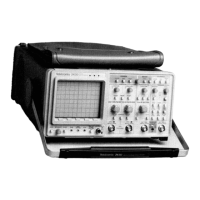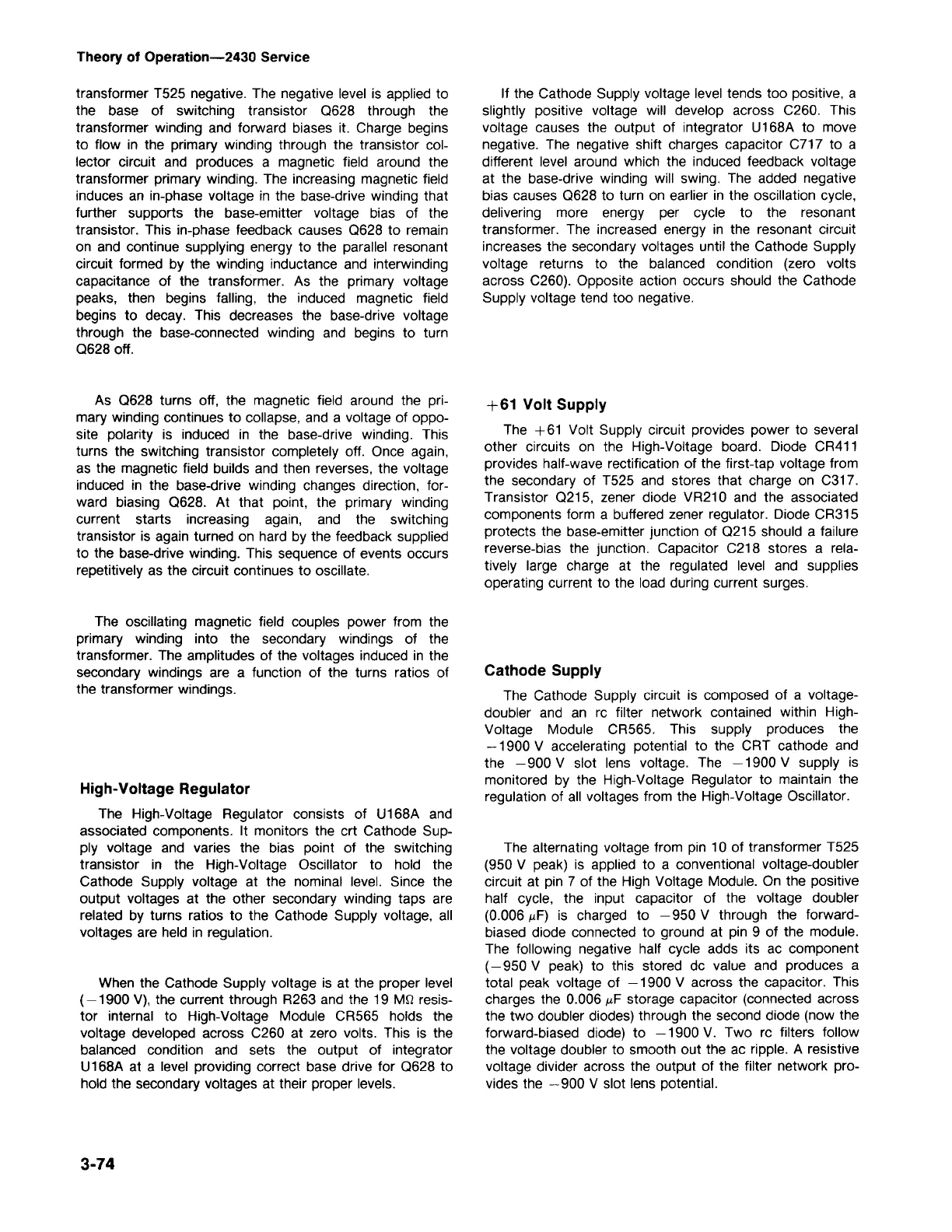The alternating voltage from pin 10 of transformer T525
(950 V peak) is applied to a conventional voltage-doubler
circuit at pin 7 of the High Voltage Module. On the positive
half cycle, the input capacitor of the voltage doubler
(0.006 fLF) is charged to -950 V through the forward-
biased diode connected to ground at pin 9 of the module.
The following negative half cycle adds its ac component
(- 950 V peak) to this stored dc value and produces a
total peak voltage of -1900 V across the capacitor. This
charges the 0.006 fLFstorage capacitor (connected across
the two doubler diodes) through the second diode (now the
forward-biased diode) to -1900 V. Two rc filters follow
the voltage doubler to smooth out the ac ripple. A resistive
voltage divider across the output of the filter network pro-
vides the - 900 V slot lens potential.
Cathode Supply
The Cathode Supply circuit is composed of a voltage-
doubler and an rc filter network contained within High-
Voltage Module CR565. This supply produces the
-1900 V accelerating potential to the CRT cathode and
the - 900 V slot lens voltage. The -1900 V supply is
monitored by the High-Voltage Regulator to maintain the
regulation of all voltages from the High-Voltage Oscillator.
+61 Volt Supply
The +61 Volt Supply circuit provides power to several
other circuits on the High-Voltage board. Diode CR411
provides half-wave rectification of the first-tap voltage from
the secondary of T525 and stores that charge on C317.
Transistor
0215,
zener diode VR210 and the associated
components form a buffered zener regulator. Diode CR315
protects the base-emitter junction of
0215
should a failure
reverse-bias the junction. Capacitor C218 stores a rela-
tively large charge at the regulated level and supplies
operating current to the load during current surges.
If the Cathode Supply voltage level tends too positive, a
slightly positive voltage will develop across C260. This
voltage causes the output of integrator U168A to move
negative. The negative shift charges capacitor C717 to a
different level around which the induced feedback voltage
at the base-drive winding will swing. The added negative
bias causes
0628
to turn on earlier in the oscillation cycle,
delivering more energy per cycle to the resonant
transformer. The increased energy in the resonant circuit
increases the secondary voltages until the Cathode Supply
voltage returns to the balanced condition (zero volts
across C260). Opposite action occurs should the Cathode
Supply voltage tend too negative.
3-74
When the Cathode Supply voltage is at the proper level
(- 1900 V), the current through R263 and the 19 Mf2resis-
tor internal to High-Voltage Module CR565 holds the
voltage developed across C260 at zero volts. This is the
balanced condition and sets the output of integrator
U168A at a level providing correct base drive for
0628
to
hold the secondary voltages at their proper levels.
High-Voltage Regulator
The High-Voltage Regulator consists of U168A and
associated components. It monitors the crt Cathode Sup-
ply voltage and varies the bias point of the switching
transistor in the High-Voltage Oscillator to hold the
Cathode Supply voltage at the nominal level. Since the
output voltages at the other secondary winding taps are
related by turns ratios to the Cathode Supply voltage, all
voltages are held in regulation.
The oscillating magnetic field couples power from the
primary winding into the secondary windings of the
transformer. The amplitudes of the voltages induced in the
secondary windings are a function of the turns ratios of
the transformer windings.
As
0628
turns off, the magnetic field around the pri-
mary winding continues to collapse, and a voltage of oppo-
site polarity is induced in the base-drive winding. This
turns the switching transistor completely off. Once again,
as the magnetic field builds and then reverses, the voltage
induced in the base-drive winding changes direction, for-
ward biasing
0628.
At that point, the primary winding
current starts increasing again, and the switching
transistor is again turned on hard by the feedback supplied
to the base-drive winding. This sequence of events occurs
repetitively as the circuit continues to oscillate.
transformer T525 negative. The negative level is applied to
the base of switching transistor
0628
through the
transformer winding and forward biases it. Charge begins
to flow in the primary winding through the transistor col-
lector circuit and produces a magnetic field around the
transformer primary winding. The increasing magnetic field
induces an in-phase voltage in the base-drive winding that
further supports the base-emitter voltage bias of the
transistor. This in-phase feedback causes
0628
to remain
on and continue supplying energy to the parallel resonant
circuit formed by the winding inductance and interwinding
capacitance of the transformer. As the primary voltage
peaks, then begins falling, the induced magnetic field
begins to decay. This decreases the base-drive voltage
through the base-connected winding and begins to turn
0628
off.
Theory of Operation-2430 Service

